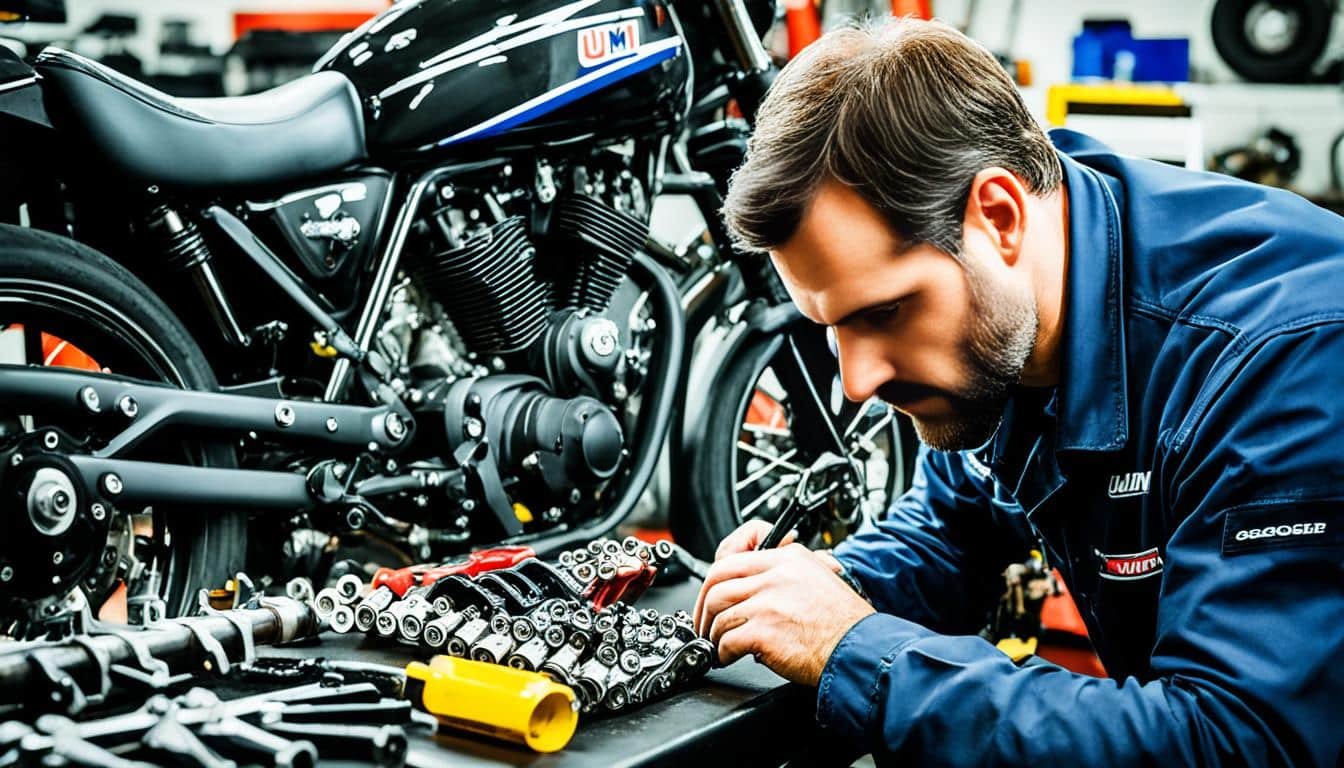UM Motorcycle Maintenance : Proper maintenance is key to keeping your UM motorcycle in top condition. One aspect that is often overlooked is the suspension setup and maintenance. Neglecting your suspension can not only affect your bike’s performance but also compromise your safety on the road. In this article, we will explore expert strategies for maintaining the suspension of your UM motorcycle, ensuring optimal performance and longevity.
Key Takeaways:
- Proper suspension setup and maintenance are crucial for performance and safety.
- Regular maintenance should be based on factors like racing frequency or annual mileage.
- Suspension deterioration is primarily caused by heat.
- Regular cleaning and inspection of the suspension are important to prevent damage.
- Breaking in a new motorcycle according to the manufacturer’s guidelines is essential for optimal performance and longevity.
Importance of Suspension Maintenance for Motorcycle Performance
When it comes to optimizing your motorcycle’s performance and ensuring a smooth ride, suspension maintenance plays a crucial role. The suspension system of your motorcycle not only absorbs impacts from the road but also affects its overall stability, cornering ability, and handling.
Suspension degradation is a common issue caused by the heat generated during operation. Over time, the oil inside the suspension can degrade, resulting in decreased performance and compromised safety. To prevent this, regular suspension maintenance becomes essential.
By following a maintenance plan and keeping your suspension in top condition, you can maintain optimal performance and prolong the lifespan of your motorcycle. Different riding habits and environments may require specific maintenance routines, so it’s important to discuss your needs with a suspension mechanic or expert.
During suspension maintenance, several elements should be inspected and addressed. These include checking for oil leaks, ensuring proper lubrication, inspecting and cleaning the suspension components, and adjusting the suspension settings based on your individual needs.
Remember, proper suspension maintenance is not just about performance; it’s also about driving safety. Well-maintained suspensions provide better control and stability, especially during high-speed maneuvers and sudden changes in road conditions.
To further illustrate the significance of suspension maintenance, consider the following quotes:
“Maintaining your motorcycle’s suspension is not just a matter of performance; it’s a matter of your safety. A well-maintained suspension contributes to better control and stability on the road.” – Motorcycle Magazine
“Neglecting suspension maintenance is like compromising your safety and the performance of your motorcycle. Proper suspension care leads to enhanced control, comfort, and overall riding experience.” – Suspension Expert
To emphasize the importance of suspension maintenance in motorcycle performance and safety, here is an image of a well-maintained motorcycle suspension system:
By incorporating a comprehensive suspension maintenance plan into your motorcycle care routine, you can experience improved performance, enhanced safety, and a more enjoyable ride. Don’t wait until your suspension shows signs of deterioration—stay proactive and give your motorcycle the attention it deserves.
Suspension Maintenance Tips for Longevity and Safety
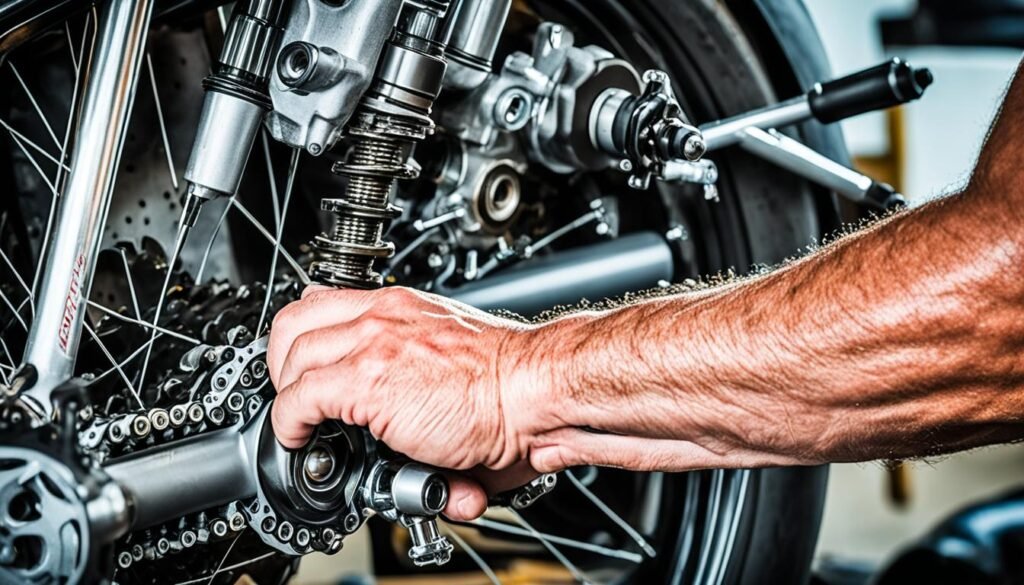
Proper suspension maintenance is essential for both the longevity of your motorcycle and your safety on the road. Neglecting suspension maintenance can lead to decreased performance and potential safety hazards. To ensure optimal suspension function, it is important to follow these maintenance tips:
1. Regularly Clean Your Suspension
Cleaning your suspension regularly helps prevent dirt and debris from accumulating and damaging the seals and sliding tubes. Use a mild soap and water solution to gently clean the suspension components, making sure to remove any grime or contaminants.
2. Inspect Before and After Each Ride
Before embarking on a ride, take a few minutes to inspect your suspension for any signs of leaks, damage, or wear. After your ride, inspect it again to ensure everything is in proper working condition. Detecting and addressing any issues early on can prevent further damage and keep you safe on the road.
3. Address Damaged Seals Immediately
If you notice any damaged seals on your suspension, such as leaks or cracks, it is crucial to address them promptly. Damaged seals can lead to oil leaks, which not only affect the performance of your suspension but can also pose a safety risk. Consult a professional suspension mechanic for proper repair or replacement.
4. Check Sliding Tubes for Damage
Inspect the sliding tubes of your suspension for any signs of damage, such as dents, scratches, or excessive wear. Any damage to the sliding tubes can negatively impact the suspension’s performance and compromise your safety. If you notice any issues, consult a professional mechanic for further evaluation and possible repair.
5. Inspect the Shock Spring
Regularly inspect the shock spring for any signs of cracks, rust, or weakening. The shock spring plays a crucial role in supporting your motorcycle’s weight and providing proper suspension function. Any damage or weakening of the shock spring should be addressed promptly to ensure optimal performance and rider safety.
By following these suspension maintenance tips, you can prolong the lifespan of your suspension system and ride with confidence knowing that your motorcycle is performing at its best.
Breaking-In Period for New Motorcycles
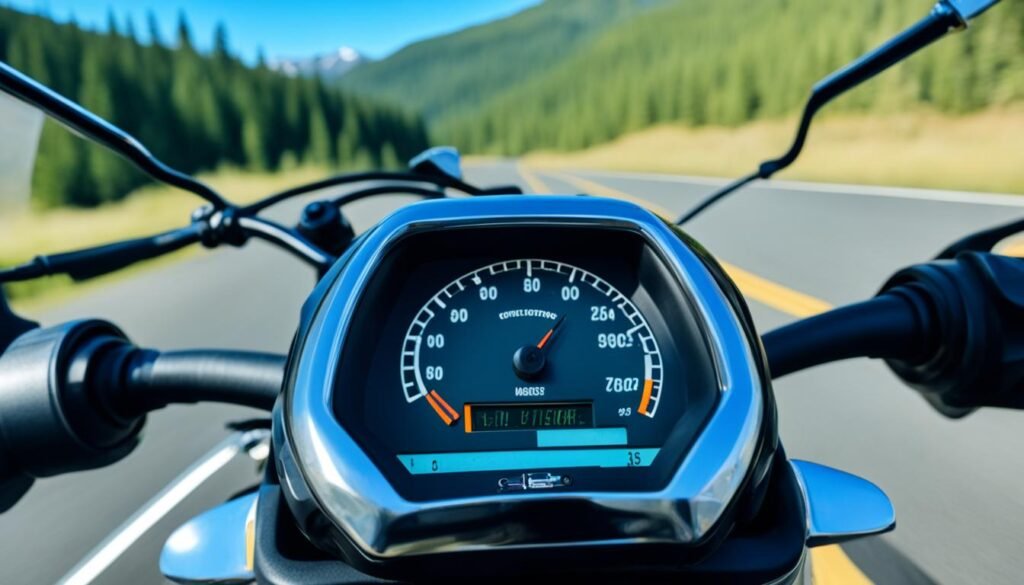
The breaking-in period for new motorcycles is a crucial stage that should be followed to ensure optimal performance and engine longevity. During this period, the internal friction within the engine is at its highest, and various components need to be properly “bedded in”. By adhering to the manufacturer’s guidelines for the breaking-in period, riders can experience a range of benefits, including lower emissions, improved fuel economy, enhanced performance, and increased engine longevity.
The first 500-1000 miles on the road are considered the breaking-in period for new motorcycles. It is during this time that the engine components settle into their designated positions and adapt to the rigors of regular operation. This process helps to minimize internal friction and allows the engine to function more efficiently.
Properly breaking in a new motorcycle can have a significant impact on its overall performance and longevity. By allowing the internal parts to gradually adjust and settle, the engine can operate smoothly, reducing the risk of premature wear and tear. This not only improves the overall performance of the motorcycle but also extends its lifespan.
During the breaking-in period, it is important to avoid aggressive riding, high speeds, and abrupt changes in throttle. Moderation is key, as excessive strain on the engine and drivetrain can hinder proper “bedding in” and potentially cause long-term damage. Following the manufacturer’s recommendations and guidelines for the specific model is essential to ensure a successful break-in process.
Throughout the breaking-in period, riders should gradually increase the engine speed and vary the throttle position to allow the components to adjust. This helps ensure that the piston rings, valves, and other moving parts properly seat and create optimal seals, reducing internal friction and promoting better overall engine performance.
In addition to following the manufacturer’s guidelines, regular oil changes and inspections are essential during the breaking-in period. This helps remove any contaminants that may accumulate during the initial stage of engine operation, allowing for optimal lubrication and reducing the risk of premature wear. Following the recommended maintenance schedule is crucial to maintain the engine’s integrity and maximize its longevity.
By properly breaking in a new motorcycle, riders can set a solid foundation for long-term performance and engine health. Taking the time and care to follow the manufacturer’s recommendations during the breaking-in period can result in a smoother running engine, improved fuel efficiency, and increased overall enjoyment of the riding experience.
The Right Way to Break-In a New Motorcycle
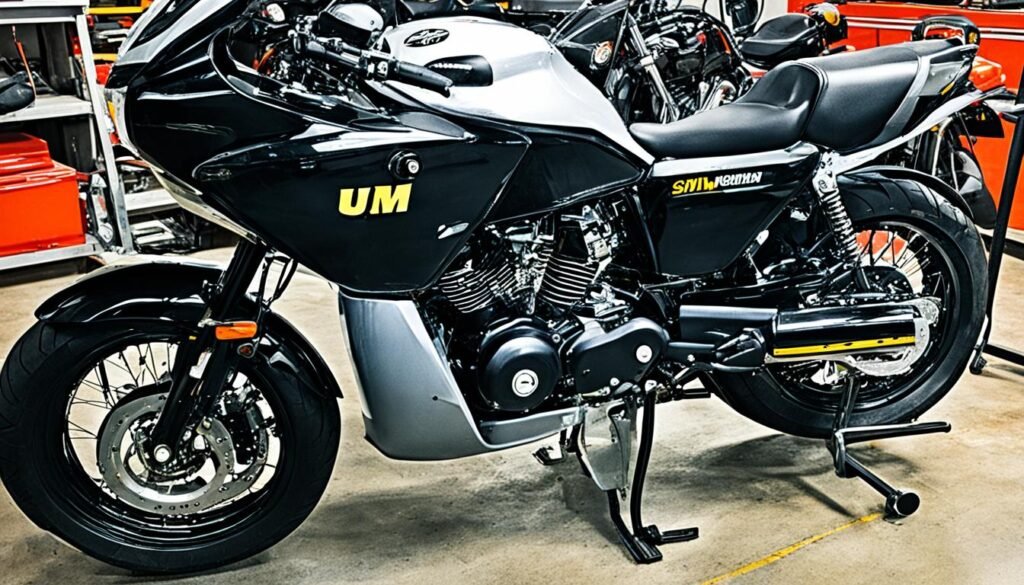
When you get a new motorcycle, it’s important to follow the correct break-in procedure outlined in the owner’s manual. This is crucial for the long-term performance and longevity of your bike. By properly breaking in your new motorcycle, you can ensure optimal engine function and avoid potential problems down the road.
Breaking in a new motorcycle involves taking certain precautions during the first 500-1000 miles of riding. The goal is to allow the engine components to ‘bed in’ and adjust to each other, ensuring smooth and efficient operation. Here are some key tips to keep in mind:
- Engine Speed: During the break-in period, it’s important to avoid high engine speeds. This means keeping the RPMs below the specified limit outlined in the owner’s manual. This allows the engine components to gradually settle and prevents excessive wear.
- Hard Stops and Rapid Acceleration: Avoid sudden, aggressive braking or rapid acceleration during the break-in period. These actions can put unnecessary stress on the engine and other mechanical components. Instead, focus on smooth, gradual stops and acceleration to give the bike time to adjust.
- Downshift Properly: When downshifting, be mindful of the engine speed and avoid downshifting when the engine begins to labor. Downshifting at appropriate engine speeds helps maintain a smooth and controlled ride.
- Mileage and Environment: During the break-in period, aim for a mix of city and highway riding to gradually introduce the bike to different conditions. Varying the engine load and RPMs promotes proper seating of the components. Additionally, try to avoid extreme weather conditions or riding in dusty environments, as these can affect the performance and longevity of your motorcycle.
By following these guidelines, you can ensure that your new motorcycle is properly broken in and ready for optimal performance. Remember to always consult your owner’s manual for specific break-in instructions tailored to your motorcycle model.
Breaking in your new motorcycle the right way is crucial for its long-term performance and longevity. By following the manufacturer’s recommended break-in procedure, you allow the engine components to settle and adjust to each other. This helps prevent premature wear and ensures smooth operation. Avoiding high engine speeds, hard stops, and rapid acceleration during the break-in period is essential. Instead, focus on gradual speed increases and smooth riding to give your new motorcycle the best start. By paying attention to these key factors and following the owner’s manual, you can enjoy the full potential of your new ride while preserving its performance and reliability for years to come.
The Consequences of Improper Motorcycle Break-In
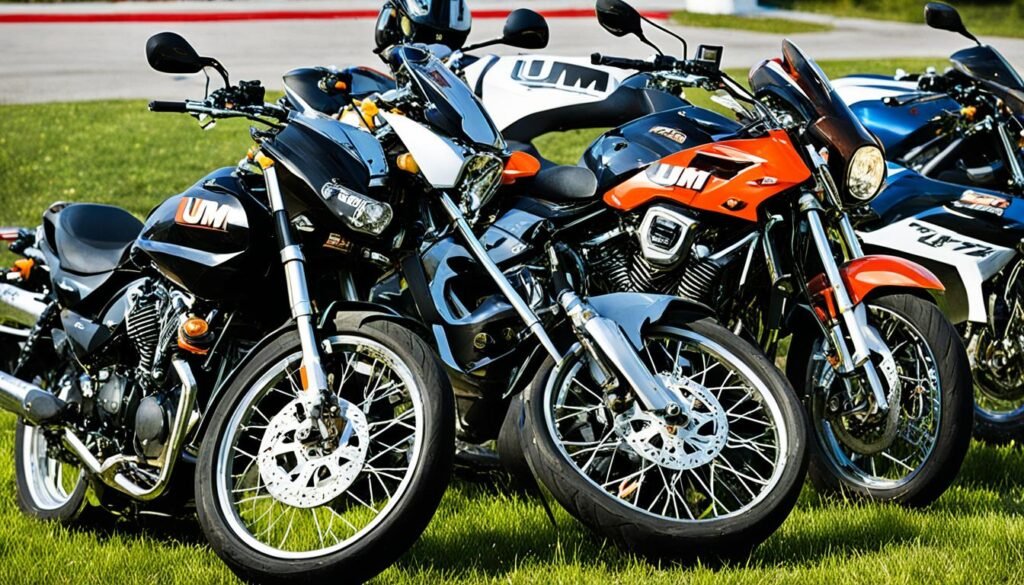
Poorly broken-in bikes can lead to a range of issues, including mediocre gas mileage and decreased performance. When riders neglect to follow the proper break-in methods or fail to adhere to the manufacturer’s recommended procedure, it can result in more frequent visits to the repair shop. It is crucial to understand the importance of a correct break-in process to ensure optimal performance and longevity for your motorcycle.
The Impact on Gas Mileage
Improperly broken-in motorcycles often suffer from subpar gas mileage. During the break-in period, the engine components need to settle and properly align, which directly affects fuel efficiency. Neglecting this process can result in higher fuel consumption and decreased mileage, leading to more frequent stops at the gas station and increased expenses in the long run.
Performance Limitations
Achieving optimal performance is the goal of every motorcycle rider. However, if a bike is not properly broken in, it can suffer from limitations in power, acceleration, and overall performance. The engine’s internal components, such as the piston rings and valves, need time to adjust and establish proper contact. Ignoring the break-in process can limit the bike’s capabilities and prevent it from reaching its full potential.
The Repair Shop Conundrum
Skipping or improperly executing the break-in period can result in unnecessary trips to the repair shop. The stress placed on the engine during a poorly executed break-in can cause premature wear and tear, leading to potential mechanical issues. To avoid frequent repairs and the associated costs, it is crucial to follow the manufacturer’s break-in recommendation and give your motorcycle the foundation it needs for a long and healthy life.
| Consequences of Improper Break-In | Effects |
|---|---|
| Mediocre Gas Mileage | Increased fuel consumption and decreased mileage |
| Performance Limitations | Reduced power, acceleration, and overall performance |
| Repair Shop Visits | Higher risk of mechanical issues and increased repair costs |
Motorcycle Safety Foundation’s Training Courses
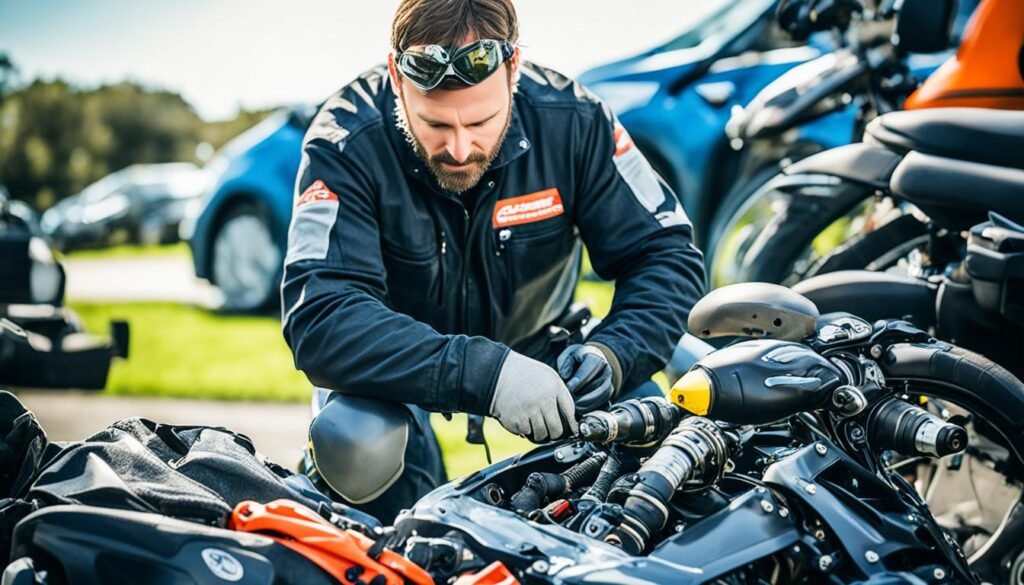
The Motorcycle Safety Foundation offers a range of comprehensive motorcycle riding courses designed for both new riders and experienced riders. With a focus on safety and skill development, these courses provide valuable knowledge and training to enhance rider competence and confidence on the road.
For new riders, the foundation offers the License Qualification Course (LQC) – a beginner’s course that covers the fundamentals of motorcycle operation and safety. This course is ideal for those who are looking to obtain their motorcycle license and learn the necessary skills to ride safely.
Experienced riders can benefit from the Rider Course, which focuses on advanced riding techniques and strategies. This course provides riders with the opportunity to refine their skills and learn advanced street strategies to navigate various riding scenarios with confidence.
Additionally, the Motorcycle Safety Foundation offers the Basic eCourse, an online training program that covers key topics such as rider safety, street strategies, and human factors. This course is a convenient option for individuals who prefer a self-paced learning experience.
With over 30 partnerships with DMVs and the US military, the Motorcycle Safety Foundation is recognized as a reputable provider of motorcycle riding courses. Their commitment to rider safety and education is evident in their comprehensive curriculum and experienced instructors.
Course Highlights:
- License Qualification Course (LQC) for new riders
- Rider Course for experienced riders
- Basic eCourse for online learning
- Street strategies and advanced riding techniques
- Focus on rider competence and confidence
Quotes:
“The Motorcycle Safety Foundation’s courses have been instrumental in improving rider safety and reducing motorcycle accidents. Their comprehensive curriculum and experienced instructors ensure that new and experienced riders receive the necessary training to navigate the road safely.” – John Smith, Experienced Rider
Motorcycle Safety Foundation’s Training Courses
| Course | Description | Target Audience |
|---|---|---|
| License Qualification Course (LQC) | A beginner’s course covering fundamental motorcycle operation and safety | New riders |
| Rider Course | An advanced course focusing on advanced riding techniques and street strategies | Experienced riders |
| Basic eCourse | An online training program that covers rider safety, street strategies, and human factors | New and experienced riders |
Importance of Education in Motorcycle Riding
The Motorcycle Safety Foundation firmly believes that education plays a critical role in ensuring the competence and confidence of motorcycle riders. By acquiring the necessary knowledge and skills, riders are able to command the saddle and embark on their journeys with a heightened sense of control and assurance. With over 50 years of experience in developing best practices and conducting research, the foundation’s training programs have consistently enhanced the riding experience for individuals across the nation.
Find the Right Motorcycle Riding Course for You

The Motorcycle Safety Foundation offers a range of courses tailored to riders of different skill levels. Whether you’re a new rider, an experienced rider, or interested in three-wheel riding, we have course options to suit your needs. Our comprehensive training programs are designed to improve your motorcycle skills and ensure your safety on the road.
New Riders
If you’re new to motorcycling, our courses provide the perfect starting point for building confidence and developing fundamental riding skills. Our basic eCourse covers essential knowledge and safety practices, while our new rider course combines classroom instruction with on-cycle exercises to give you hands-on experience in a controlled environment.
Experienced Riders
Experienced riders can benefit from our advanced courses, which focus on honing existing skills and expanding knowledge. The street strategies course helps riders navigate real-world riding scenarios, while the rider course offers advanced training in areas such as braking, cornering, and swerving techniques.
Three-Wheel Riders
If you prefer the stability of a three-wheel motorcycle, we also offer courses specifically designed for three-wheel riders. These courses cover the unique dynamics and handling characteristics of three-wheel motorcycles, providing you with the skills necessary to ride safely and confidently.
With our diverse course options, you can choose the training that matches your skill level and specific riding preferences. From basic eCourses to more advanced license qualification courses, the Motorcycle Safety Foundation has you covered. Improve your riding skills and enhance your safety on the road by enrolling in one of our courses today.
Conclusion
In conclusion, implementing expert strategies and best practices is crucial for maintaining UM motorcycles. Proper suspension maintenance is essential for enhancing performance and ensuring safety on the road. By regularly adjusting and maintaining the suspension, riders can optimize their motorcycle’s performance and longevity.
Additionally, following the correct break-in methods for new motorcycles is vital for long-term engine performance and durability. Adhering to the manufacturer’s recommended break-in procedure helps reduce internal friction, resulting in lower emissions, improved fuel economy, and increased engine longevity.
The Motorcycle Safety Foundation’s training courses offer valuable education and skill development for riders of all levels. Whether you are a new rider or an experienced one, these courses provide the knowledge and techniques needed to enhance riding competence and confidence. By enrolling in these courses, riders can further improve their understanding of motorcycle safety and be better equipped to navigate various situations on the road.
By employing expert strategies, following proper maintenance procedures, and continuously improving skills through education and training, UM motorcycle owners can ensure optimal performance and longevity from their bikes. With these best practices in place, riders can confidently embark on their journeys and enjoy the thrill of riding while prioritizing safety.
Also Refer : Stay Safe On Your Bike: Ultimate UM Bike Safety Tips For Riders
FAQs
Q: What is UM motorcycle maintenance?
A: UM motorcycle maintenance refers to the regular upkeep and servicing of UM motorcycles to ensure their optimal performance, safety, and longevity.
Q: What are the recommended maintenance intervals for UM motorcycles?
A: The recommended maintenance intervals for UM motorcycles vary by model and year, but generally, regular servicing is advised every 3,000 to 5,000 miles or at least once a year.
Q: How can I find the nearest UM service center for maintenance?
A: To find the nearest UM service center for maintenance, you can visit the official UM Motorcycles website and use their service center locator tool, or contact UM customer service for assistance.
Q: What are some key tips for maintaining the battery of a UM motorcycle?
A: To maintain the battery of a UM motorcycle, it is important to keep it charged, clean the terminals regularly, and ensure proper insulation to prevent electrical issues.
Q: How can I troubleshoot an issue with the indicator on my UM bike?
A: If you encounter issues with the indicator on your UM bike, check the bulbs, wiring, and fuse. If the problem persists, consult a qualified mechanic or visit a UM service center for diagnosis and repair vehicle manufacturer.
Q: Are there any upcoming changes or updates for UM motorcycles in 2023?
A: While specific details may vary, UM Motorcycles has plans for new models, features, or updates for the 2023 lineup. Stay tuned to official UM communications for the latest information 2024.
